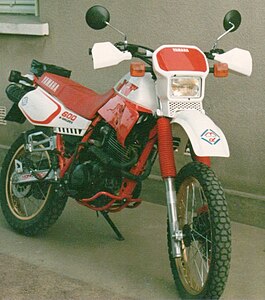Yamaha XT 600
| Yamaha | |
|---|---|
 Model 2KF from 1987 with kick starter |
|
| XT 600 | |
| Manufacturer | Yamaha engine |
| Sales description | XT 600 |
| Production period | 1984 to 2003 |
| class | motorcycle |
| design type | Enduro |
| Motor data | |
| Air-cooled single cylinder engine | |
| Displacement (cm³) | 595 |
| Power (kW / PS ) | 20 kW at 6000 min -1
33/45 at 6600 min -1 |
| Torque ( N m ) | 50 Nm at 5500 min -1 |
| Top speed ( km / h) | 144 |
| transmission | 5 courses |
| drive | O-ring chain |
| Brakes | front: Ø 298 mm disc brake rear: Ø 245 mm disc brake / Drum brake (type 43F) |
| Wheelbase (mm) | 1440 |
| Seat height (cm) | 88 |
| Empty weight (kg) | 159 |
| Previous model | Yamaha XT 550 |
| successor | Yamaha XT 660 R. |
The Yamaha XT 600 is a motorcycle from the Japanese motorcycle manufacturer Yamaha , which was built in various versions from 1984 to 2003 and was the most popular enduro of that time.
Model history
The XT 600 is an all-purpose enduro, which is suitable for both road use and off-road driving. With disc brakes, four-valve engines, mono strut (Mono Cross) and modern 12 V electrics, it received significant innovations compared to the Yamaha XT 500 introduced in 1975 .
The first XT 600 came on the market in 1984 a year after the XT 600 Z Ténéré . In addition to the design, the main difference was the compact 11.5-liter tank instead of the 28-liter "barrel" of the Ténéré long-distance travel variant . The street model Yamaha SRX 600 was later derived. From 1991 onwards, the XT 600 Z Ténéré , which was technically a bit dated, was replaced by the water-cooled Yamaha XTZ 660 , which no longer had the same off-road capability as the previous model.
Over the years, the XT 600 has been built in different versions, which mostly only differ in appearance. The most important change to the XT 600 , which previously could only be started with a kick starter , took place in 1990 when a new model with a more modern design, shorter spring travel, chrome-plated steel instead of aluminum rims, now without a rev counter, with the exhaust as the supporting frame part, a 13, 9-liter tank and an electric starter under the designation XT 600 e was introduced. In addition, the oil tank, which was previously located under the left side cover, moved forward behind the steering head between the frame bridge and the girder. Due to high demand came shortly after an otherwise with the XT 600 E identical model with Kickstarter to the market, which now than XT 600 K was called. In 1995 the XT 600 K model series was phased out. The output of the XT 600 E , which is now the only one available , has been reduced by 4 kilowatts to 29 kW due to stricter emission requirements, and a tachometer has been reintegrated in the cockpit. The clutch control on the short engine moved from the left to the right side, and the rear silencer was no longer part of the rear frame. The XT survives mileages of up to 60,000 kilometers without an engine overhaul.
Technical specifications
- Type: 3UW Bj. 94
- Empty weight: 163 kg (Type 43F, year of construction 1984 to 1986: 151 kg) (Type 2KF, year of construction 1987 to 1989: 153 kg)
- Standpipe diameter 41 mm, spring travel 255 mm at the front, 225 mm at the rear (type 2KF 235 mm at the rear)
- air-cooled four-stroke engine, 4-valve
- a cylinder, arranged upright
- Bore: 95 mm
- Stroke: 84 mm
- Compression: 8.5: 1
- Top speed: 135–160 km / h (depending on the model)
- Power: 27-46 hp (depending on the throttling)
- Chain drive
Model variants
| Construction year | serial number | designation | power |
|---|---|---|---|
| 1983-84 | 34L | XT 600 Z | 20/33 kW |
| 1985 | 55W | XT 600 Z | 20/33 kW |
| 1986-87 | 1VJ | XT 600 Z | 20/34 kW |
| 1988-90 | 3AJ | XT 600 Z | 20/25/34 kW |
| 1984-86 | 43F | XT 600 | 20/33 kW |
| 1987-89 | 2KF | XT 600 | 33 kW |
| 1987-89 | 2NF | XT 600 | limited to 20 kW |
| 1990-94 | 3UW | XT 600 E and K | limited to 20 kW |
| 1990-94 | 3TB | XT 600 E and K | 33 kW |
| 1995-97 | 3TB | XT 600 E | 25/29 kW |
| 1997-99 | VJ01 | XT 600 E | 25/29 kW |
| 1999-03 | DJ02 | XT 600 E | 25/29 kW |
Reviews
“The Yamaha XT 600 E is definitely not oozing with thick paint and shiny chrome. However, it is robust, durable and reliable. Ideal for the city, fun on the country road. Those are the positives. For the long journey you have to be patient, you have to take it easy here. "
literature
- Bucheli Publisher: Yamaha XT 600 Tenere / XT 600 from year of construction 1983: Manual for care, maintenance and repair . ISBN 3-7168-1789-9 .
- Bucheli Verlag: Yamaha XT 600 E from 1990 . ISBN 3-7168-1869-0 .
Web links
Individual evidence
- ↑ Yamaha XT 600 E . In: Touring Driver . Retrieved March 15, 2015.
- ↑ Japanese stew. In: Biker scene. Retrieved March 15, 2015 .